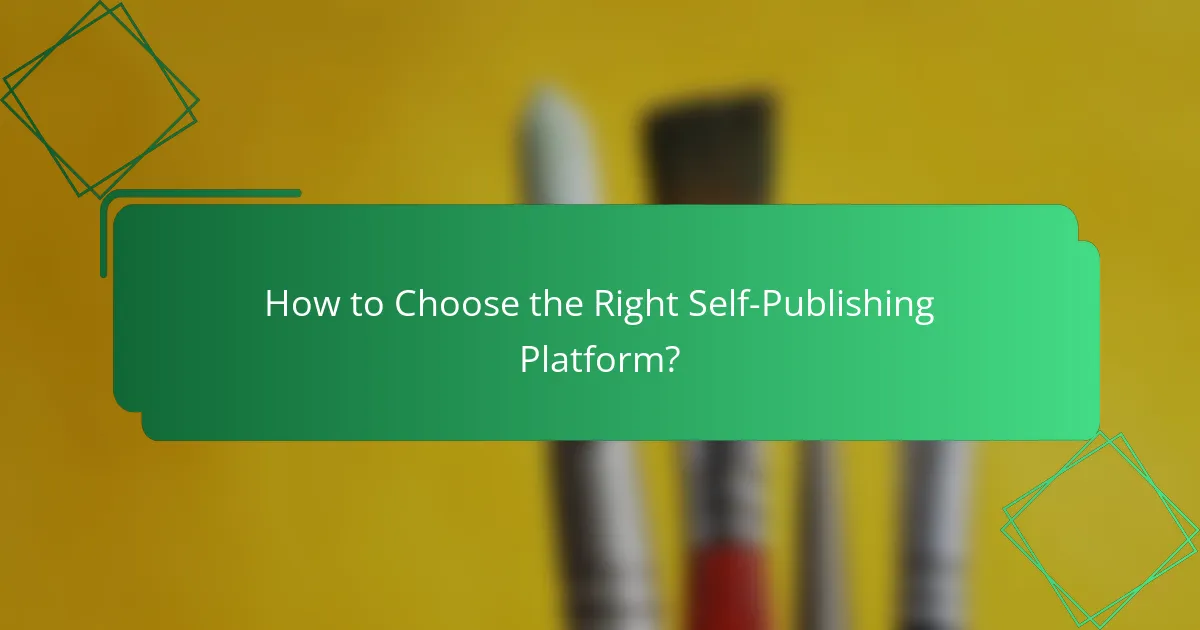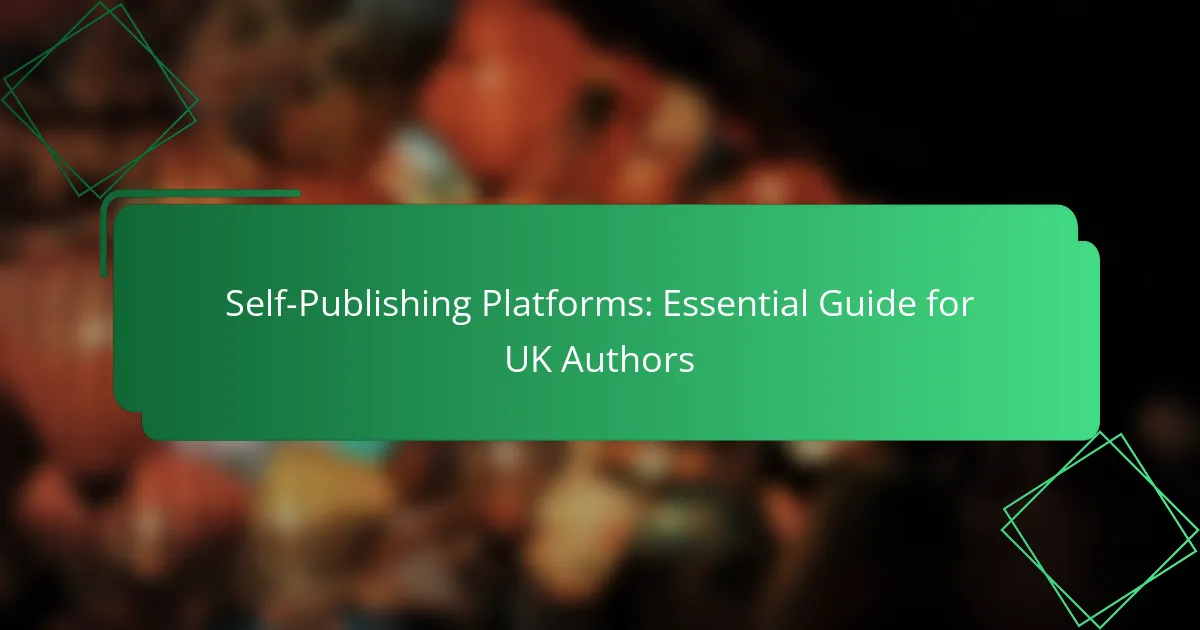For UK authors looking to self-publish, choosing the right platform is essential to ensure effective distribution and maximize royalties. Options like Amazon Kindle Direct Publishing, IngramSpark, and Lulu each offer distinct features tailored to various author needs. By understanding the costs and benefits associated with each platform, authors can make informed decisions that align with their publishing goals.

What Are the Best Self-Publishing Platforms for UK Authors?
The best self-publishing platforms for UK authors include Amazon Kindle Direct Publishing, IngramSpark, Lulu, Smashwords, and Draft2Digital. Each platform offers unique features, distribution options, and pricing structures that cater to different author needs.
Amazon Kindle Direct Publishing
Amazon Kindle Direct Publishing (KDP) is one of the most popular platforms for self-publishing eBooks and paperbacks. It allows authors to publish their work for free and earn royalties of up to 70% on eBook sales. KDP’s extensive reach means your book can be available to millions of readers globally.
To get started, create an account, upload your manuscript, and set your pricing. Consider enrolling in KDP Select for additional promotional opportunities, but be aware that this requires exclusivity to Amazon for your eBook.
IngramSpark
IngramSpark is a robust platform for authors looking to publish both print and digital books. It provides access to a vast distribution network, including bookstores and libraries, which can significantly increase your book’s visibility. However, there are setup fees involved, typically around £40 for print and eBook formats.
Authors should prepare their files according to IngramSpark’s specifications to avoid costly revisions. This platform is ideal for those aiming for a professional finish and wider distribution beyond Amazon.
Lulu
Lulu is a versatile self-publishing platform that supports a variety of formats, including photo books, calendars, and standard novels. It offers a user-friendly interface and allows authors to set their own prices while earning royalties. Lulu’s print-on-demand service means you only pay for copies when they are ordered.
Consider using Lulu if you want to create unique formats or if you plan to sell directly to consumers through your own website. Keep in mind that while Lulu has extensive distribution options, they may not be as comprehensive as IngramSpark’s.
Smashwords
Smashwords is an eBook distribution platform that allows authors to publish and distribute their work to major retailers like Apple Books and Barnes & Noble. It offers a straightforward publishing process and provides authors with a royalty rate of around 60% on sales.
Authors should focus on formatting their manuscripts according to Smashwords’ style guide to ensure a smooth publishing experience. This platform is particularly beneficial for those looking to reach a wide audience across multiple eBook retailers.
Draft2Digital
Draft2Digital is another user-friendly platform that simplifies the self-publishing process. It offers free formatting tools and distributes eBooks to various retailers, including Kobo and Amazon. Authors can earn around 60% royalties on sales, making it a cost-effective option.
One of the standout features of Draft2Digital is its automated updates, which ensure that any changes made to your book are reflected across all retailers. This platform is ideal for authors who want an easy-to-use service with broad distribution capabilities.

How to Choose the Right Self-Publishing Platform?
Selecting the right self-publishing platform is crucial for UK authors, as it impacts distribution, royalties, and overall ease of publishing. Consider your specific needs, such as target audience and preferred sales channels, to make an informed choice.
Consider distribution reach
Distribution reach refers to how widely your book can be sold across various platforms and retailers. Look for platforms that offer access to major online bookstores like Amazon, Apple Books, and Google Play, as well as local UK retailers.
Some platforms may also provide options for print-on-demand services, which can expand your reach to physical bookstores. Evaluate whether the platform allows you to distribute internationally if you have a global audience in mind.
Evaluate royalty rates
Royalty rates determine how much you earn from each sale, and they can vary significantly between platforms. Most self-publishing platforms offer royalty rates ranging from 35% to 70% for eBooks, while print royalties are often lower, typically around 40% to 60% after printing costs.
Compare the royalty structures of different platforms to understand potential earnings. Be cautious of hidden fees that could reduce your overall income, and consider how pricing strategies might affect your royalties.
Assess ease of use
The ease of use of a self-publishing platform can significantly affect your publishing experience. Look for platforms with user-friendly interfaces and clear instructions for uploading your manuscript, cover design, and other necessary elements.
Some platforms offer templates and tools to simplify the formatting process, which can save you time and effort. Read reviews or seek recommendations from other authors to gauge the user experience before committing.
Check formatting requirements
Each self-publishing platform has specific formatting requirements for manuscripts and covers. Familiarize yourself with these guidelines to ensure your book meets the necessary standards for publication.
Common formats include PDF for print and ePub or MOBI for eBooks. Some platforms may provide formatting services, but if you choose to format your book yourself, consider using tools like Scrivener or Vellum to streamline the process.

What Are the Costs Involved in Self-Publishing in the UK?
Self-publishing in the UK involves several costs that authors should consider, including platform fees, editing and design expenses, and marketing costs. Understanding these expenses can help authors budget effectively and maximize their potential returns.
Platform fees
Platform fees refer to the charges imposed by self-publishing services for using their platforms. These can vary widely, with some platforms charging a flat fee while others take a percentage of sales, typically ranging from 15% to 30% of royalties.
Popular platforms like Amazon Kindle Direct Publishing (KDP) and IngramSpark have different fee structures. For instance, KDP does not charge upfront fees but takes a percentage of sales, while IngramSpark charges a setup fee but offers broader distribution options.
Editing and design costs
Editing and design are crucial for producing a professional-quality book. Editing costs can range from £200 to £1,500 or more, depending on the level of editing required, such as developmental editing or copyediting.
Cover design is another important aspect, with prices typically between £100 and £500. Investing in high-quality editing and design can significantly enhance the book’s appeal and marketability.
Marketing expenses
Marketing expenses can vary greatly based on the strategies employed. Authors may spend anywhere from £50 to several thousand pounds on marketing campaigns, including social media ads, book launch events, and promotional materials.
Effective marketing is essential for reaching potential readers. Consider allocating a budget for online advertising, book reviews, and promotional giveaways to boost visibility and sales.

What Are the Key Features of Successful Self-Publishing Platforms?
Successful self-publishing platforms typically offer a combination of user-friendly interfaces, comprehensive support, and robust marketing tools. These features ensure that authors can easily navigate the publishing process, receive assistance when needed, and effectively promote their work.
User-friendly interface
A user-friendly interface is crucial for authors who may not be tech-savvy. Platforms should provide intuitive navigation, clear instructions, and a streamlined process for uploading manuscripts and cover designs. Look for features like drag-and-drop functionality and easy access to formatting tools.
Consider platforms that offer templates specifically designed for various genres, as these can simplify the publishing process. A good interface can significantly reduce the time spent on technical issues, allowing authors to focus on their writing.
Comprehensive support
Comprehensive support is essential for authors navigating the self-publishing landscape. This includes access to customer service via multiple channels, such as email, chat, and phone. Additionally, platforms should provide resources like FAQs, tutorials, and community forums to assist authors at every stage.
Look for platforms that offer personalized support, such as one-on-one consultations or feedback on your manuscript. This can be particularly beneficial for new authors who may have questions about formatting, distribution, or marketing strategies.
Robust marketing tools
Robust marketing tools are vital for authors to effectively promote their books. Successful platforms often include features such as social media integration, email marketing options, and promotional pricing strategies. These tools can help authors reach wider audiences and boost sales.
Consider platforms that provide analytics to track sales performance and reader engagement. This data can guide your marketing efforts and help you refine your strategies over time. Additionally, look for options that allow you to create promotional campaigns easily, such as discounts or giveaways, to attract more readers.

What Are Common Challenges Faced by UK Self-Published Authors?
UK self-published authors often encounter several challenges that can impact their success. These include market saturation, marketing difficulties, and issues with distribution and quality control.
Market saturation
Market saturation is a significant challenge for UK self-published authors, as the number of available titles continues to grow rapidly. With thousands of new books released each month, standing out in a crowded marketplace requires strategic planning and effective marketing.
To navigate market saturation, authors should focus on niche genres or unique themes that resonate with specific audiences. Researching current trends and reader preferences can help identify gaps in the market, allowing authors to tailor their work accordingly.
Additionally, building an author brand through social media and engaging with readers can enhance visibility. Authors should consider using platforms like Instagram or Twitter to connect with potential readers and promote their work effectively.
